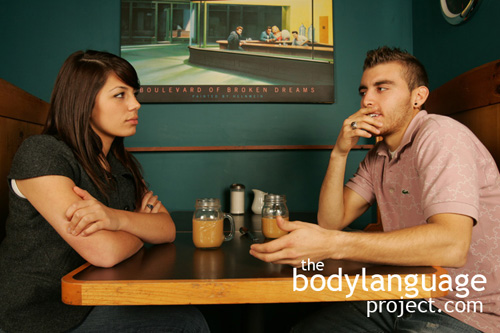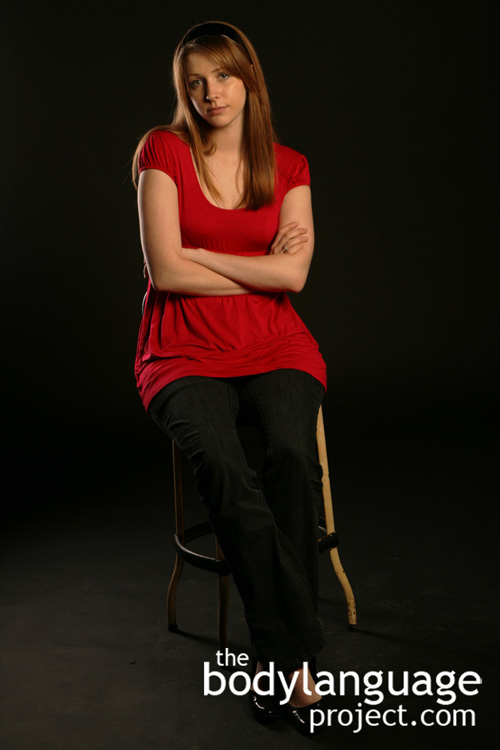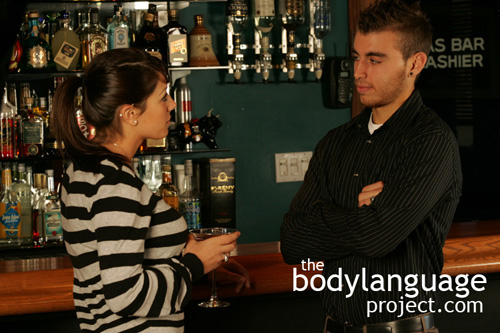The Body Language Meaning Of Becoming Loud
Cue: Becoming Loud
Synonym(s): Loud Voice, Screaming, Shouting, Yelling.
Description: A sudden or sustained increase in the volume of the voice.
In One Sentence: Yelling implies that there is a rise in emotion which signals a heightened state of emotions including joy or anger.
How To Use it: Use a loud voice to boost your dominance over other people. It is most effective if used with a baritone voice. A loud screechy voice can make one noticed and feared, but does nothing to boost credibility. You may also decide to use a loud voice to show your excitement.
Context: General.
Verbal Translation: “I’m here and I’m talking right now, the more people that notice my booming voice, the better!”, “I am raising my voice to validate my argument, boost my dominance, and really drive my point home through vocal force.”
Variant: See Becoming Quiet or Whispering.
Cue In Action: When she got really angry, her voice turned from meek and pleasant to a deafening shriek.
Meaning and/or Motivation: Becoming loud can be due to a variety of reasons including an attempt to be noticed, to dominate a room, to express anger or frustration, act out aggressively, berate, scorn, celebrate and show excitement, display enjoyment, or due to inebriation.
Cue Cluster: Coupled with a loud voice, the arms might begin to motion erratically. When this occurs it shows that a person has lost control of their emotions and is expressing frustration and anger.
Body Language Category: Anger, Dominant body language, Emotional body language, Frustration or frustrated body language, Threat displays, Power play, Authoritative body language.
Resources:
Aaron, Sell; Cosmides, Leda and Tooby, John. The Human Anger Face Evolved to Enhance Cues of Strength. Evolution and Human Behavior. 2014. 35(5): 425-429.
http://bodylanguageproject.com/articles/the-universal-anger-face/
Abitbol, J., Abitbol, P., & Abitbol, B. (1999). Sex hormones and the female voice. Journal of Voice, 13, 424–446.
Apicella, Coren L. and David R. Feinberg. Voice Pitch Alters Mate-Choice-Relevant Perception in Hunter–Gatherers. Proc. R. Soc. B. 2009. 276: 1077–1082 doi:10.1098/rspb.2008.1542
http://bodylanguageproject.com/articles/impress-higher-pitched-voice/
Bachorowski, J., & Owren, M. J. (1995). Vocal expression of emotion: Acoustic properties of speech are associated with emotional intensity and context. Psychological Science, 6, 219–224.
Brown, L.M. (1998) Raising their Voices: The Politics of Girls’ Anger. Cambridge, MA: Harvard University Press.
Fraccaro, Paul J.; Benedict C. Jones; Jovana Vukovic; Finlay G. Smith; Christopher D. Watkins; David R. Feinberg; Anthony C. Little and Lisa M. Debruine. Experimental Evidence That Women Speak in a Higher Voice Pitch to Men They Find Attractive. Journal of Evolutionary Psychology. 2011. 9(1): 57-67.
http://bodylanguageproject.com/articles/women-raise-voice-pitch-men-find-attractive/
Fraccaro, Paul J.; Jillian J. M. O’Connor; Daniel E. Re; Benedict C. Jones; Lisa M. DeBruine and David R. Feinberg. Faking it: Deliberately Altered Voice Pitch and Vocal Attractiveness. Animal Behaviour. 2013. 85: 127e136. http://bodylanguageproject.com/articles/sound-little-atypical-measuring-artificial-lowering-raising-voice-pitch-men-women/
Gobl C, Nı´ Chasaide A (2003) The role of voice quality in communicating emotion, mood and attitude. Speech Commun 40: 189–212. doi: 10.1016/ S0167-6393(02)00082-1.
Herold, Debora S.; Nygaard, Lynne C.; Chicos, Kelly A. and Namy, Laura L. The Developing Role of Prosody in Novel Word Interpretation. Journal of Experimental Child Psychology. 2011. 108(2): 229-241.
Hughes, Susan M.; Franco Dispenza and Gordon G. Gallup Jr.. Ratings of voice attractiveness predict sexual behavior and body configuration. Evolution and Human Behavior. 2004; 25: 295–304.
http://bodylanguageproject.com/articles/sexy-voices-linked-sexy-bodies-sexual-success/
Hughes, S. M., and Gallup Jr., G. G. (2003). Sex differences in morphological predictors of sexual behavior: shoulder to hip and waist to hip ratios. Evolution and Human Behavior, 24, 173–178.
Hughes, S. M., Harrison, M. A., & Gallup Jr., G. G. (2002). The sound of symmetry: voice as a marker of developmental instability. Evolution and Human Behavior, 23, 173–180.
Hughes, Susan M.; Franco Dispenza and Gordon G. Gallup Jr.. Ratings of voice attractiveness predict sexual behavior and body configuration. Evolution and Human Behavior. 2004; 25: 295–304.
http://bodylanguageproject.com/articles/sexy-voices-linked-to-sexy-bodies-and-sexual-success/
Hughes, S. M., & Gallup Jr., G. G. (2003). Sex differences in morphological predictors of sexual behavior: shoulder to hip and waist to hip ratios. Evolution and Human Behavior, 24, 173–178.
Herold, Debora S. ; Nygaard, Lynne C. ; Namy, Laura L. Say It like You Mean It: Mothers’ Use of Prosody to Convey Word Meaning. Language and Speech. 2012. 55(3): 423-436.
Krauss, R. M., Freyberg, R., & Morsella, E. (2002). Inferring speakers’ physical attributes from their voices. Journal of Experimental Social Psychology, 38, 618–625.
Lass, N. J., & Colt, E. G. (1980). A comparative study of the effect of visual and auditory cues on speaker height and weight identification. Journal of Phonetics, 8, 277–285.
Laukkanen A-M, Vilkman E, Alku P, Oksanen H (1997) On the perception of emotions in speech: The role of voice quality. Logoped Phoniatr Vocol 22: 157– 168. doi: 10.3109/14015439709075330.
Lass, N. J., & Davis, M. (1976). An investigation of speaker height and weight identification. Journal of the Acoustical Society of America, 60, 700–704.
Leongómez, Juan David; Jakub Binter; Lydie Kubicová; Petra Stolarová; Katerina Klapilová and Jan Havlícek, S. Craig Roberts. Vocal Modulation During Courtship Increases Proceptivity Even in Naive Listeners. Evolution and Human Behavior. 2014. doi: 10.1016/j.evolhumbehav.2014.06.008.
http://bodylanguageproject.com/articles/voice-pitching-courtship-competition/
Mikach, S. M., and Bailey, M. (1999). What distinguishes women with unusually high numbers of sex partners? Evolution and Human Behavior, 20, 141–150.
Nygaard, L. C., & Queen, J. S. (2008). Communicating emotion: Linking affective prosody and word meaning. Journal of Experimental Psychology: Human Perception and Performance, 34, 1017–1030.
Puts, David A.; Julia L. Barnd; Lisa L.M.; Welling, Khytam Dawood; and Robert P. Burriss. Intrasexual Competition Among Women: Vocal Femininity Affects Perceptions of Attractiveness And Flirtatiousness. Personality and Individual Differences. 2011; 50: 111-115.
http://bodylanguageproject.com/articles/women-use-voice-pitch-flirt-compete-men
Puts, David A; Coren L. Apicella and Rodrigo A. Cárdenas. Masculine Voices Signal Men’s Threat Potential in Forager and Industrial Societies. Proceedings of the Royal Society. 2011. doi: 10.1098/rspb.2011.0829
http://bodylanguageproject.com/articles/deep-voice-signals-potential-threat-use-body-language-dominance/
Sturman, Edward D. Invluntary Subordination and Its Relation to Personality, Mood,
and Submissive Behavior. Psychological Assessment. 2011. 23(1): 262-276 DOI: 10.1037/a0021499
http://bodylanguageproject.com/articles/nonverbal-submission-men-women-depression-critical-examination-use-disuse-submission/
Sei Jin Ko; Melody S. Sadler and Adam D. Galinsky. The Sound of Power Conveying and Detecting Hierarchical Rank Through Voice. Psychological Science. 2014. DOI: 956797614553009
http://bodylanguageproject.com/articles/power-produces-dominance-voice-study/
Sally D. Farley, Susan M. Hughes, Jack N. LaFayette. People Will Know We Are in Love: Evidence of Differences Between Vocal Samples Directed Toward Lovers and Friends. Journal of Nonverbal Behavior, 2013; 37 (3): 123.
http://bodylanguageproject.com/articles/are-they-cheating-research-says-voice-may-betray-them/
Susan Hughes, Justin Mogilski, Marissa Harrison. The Perception and Parameters of Intentional Voice Manipulation. Journal of Nonverbal Behavior, 2014 DOI: 10.1007/s10919-013-0163
http://bodylanguageproject.com/articles/her-voice-is-hot-his-is-not/
Scherer, K., Banse, R., Wallbott, H., & Goldbeck, T. (1991). Vocal cues in emotion encoding and decoding. Motivation and Emotion, 15, 123–148.
Scherer, Klaus R. Personality inference from voice quality: The loud voice of extroversion. European Journal of Social Psychology. 1978 8(4): 467-487.
Scherer KR (2003) Vocal communication of emotion: A review of research paradigms. Speech Commun 40: 227–256. doi: 10.1016/S0167-6393(02)00084-5.
Singh, L., Morgan, J. L., & Best, C. T. (2002). Infants’ listening preferences: Baby talk or happy talk? Infancy, 3, 365–394.
Scherer, Klaus R. Personality inference from voice quality: The loud voice of extroversion. European Journal of Social Psychology. 1978 8(4): 467-487.
Siegman, Aron Wolfe ; Boyle and Stephen Mineka. Voices of Fear and Anxiety and Sadness and Depression: The Effects of Speech Rate and Loudness on Fear and Anxiety and Sadness and Depression. Journal of Abnormal Psychology. 1993. 102(3): 430-437.
Trainor, L. J., Austin, C. M., & Desjardins, R. N. (2000). Is infant-directed speech prosody a result of the vocal expression of emotion? Psychological Science, 11, 188–195.
Walker-Andrews, A., & Grolnick, W. (1983). Discrimination of vocal expressions by young infants. Infant Behavior and Development, 6, 491–498.
Zuckerman, M., & Driver, R. (1989). What sounds beautiful is good: the vocal attractiveness stereotype. Journal of Nonverbal Behavior, 13, 67–82.





